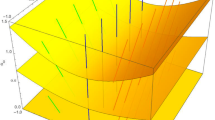Summary
Gravitational theories can be written in terms of rescaled fields without the Planck mass. The rescaled tetrads acquire the dimension of mass. The actual distribution of energy throughout space-time causes the tetrads to assume vacuum expected values of the order of the Planck mass,m p. Thus the gravitational constant,G=ħc/m 2P , may be viewed not as a fundamental constant, but as a mass scale that is dynamically determined by the large-scale structure of the Universe.
Similar content being viewed by others
Footnotes
K. Cahill:Phys. Rev. D,26, 1916 (1982).
K. Cahill: preprint DOE-UNM-83/1.
V. de Alfaro, S. Fubini andG. Furlan:Nuovo Cimento A,50, 523 (1979);Nuovo Cimento B,57, 227 (1980);Phys. Lett. B,97, 67 (1980); inUnification of the Fundamental Interactions, Erice, 1981, edited byEllis andFerrara (New York, N.Y., 1983);Z. Phys. C,18, 349 (1983).
V. de Alfaro: inThe High-Energy Limit, Erice, 1980, edited byA. Zichichi (New York, N.Y., 1981), p. 149.
J. C. Ward:Proc. Natl. Acad. Sci. USA,75, No. 6, 2568 (1978).
Author information
Authors and Affiliations
Additional information
Supported in part by the U.S. Department of Energy under contract DE-AC04-81ER40042.
Rights and permissions
About this article
Cite this article
Cahill, K. The gravitational constant. Lett. Nuovo Cimento 39, 181–184 (1984). https://doi.org/10.1007/BF02790586
Received:
Revised:
Published:
Issue Date:
DOI: https://doi.org/10.1007/BF02790586




